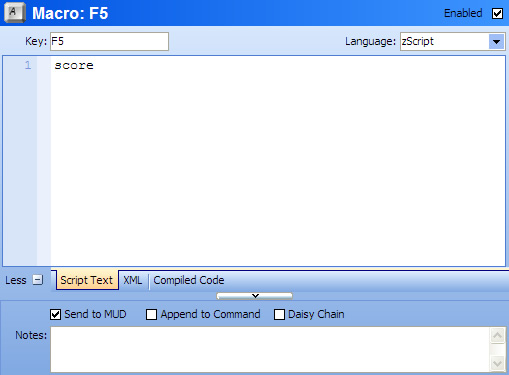|
|
 |
|
|
When you select a Macro setting and open the advanced options panel at the bottom, you will get an editor panel like this:

- Enabled
- Determines if this alias is enabled or disabled.
- Key
- This is the name of the key that the macro is assigned to. If you click on this field, a help message will be displayed at the bottom of the window instructing you to press the Enter key and then press the key you want to assign the macro to.
- Script
- This is the full script of the macro. See the Scripting topic for more information.
- Language
- Select the scripting language used for this macro. Built-in languages include: zScript, Lua, VBScript, and JavaScript. But any other scripting language installed into the Windows Scripting Host can also be used.
- Script Text / XML / Compiled Code
- Selecting the Compiled Code tab will show the low-level code generated by this macro. This is for internal testing purposes and is not documented further. Selecting the XML tab will allow you to edit the raw XML data used for copy/paste and import/export.
- Send to MUD
- When checked, the text in the Script field is sent to the MUD directly.
- Append to Command
- When checked, the text in the Script field is appended to the current text in the command line.
- Daisy Chain
- When selected, this macro can be chained to another macro. For example, if you had a macro assigned to the F5 key with a script of "go " and then had a macro assigned to the KEY8 number-pad key with the script of "north" and the Daisy Chain option set, then you could press F5 and then KEY8 to send "go north" to the MUD.
- Notes
- Used to store comments with the macro. You might use this to remind yourself what the macro is used for.
See the Introduction to Macros for more information. |
|
